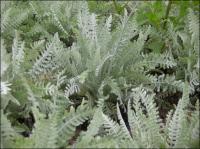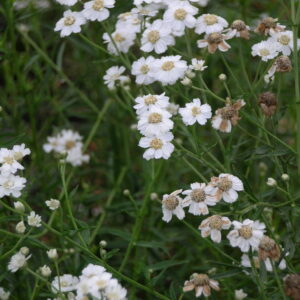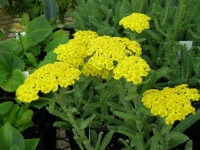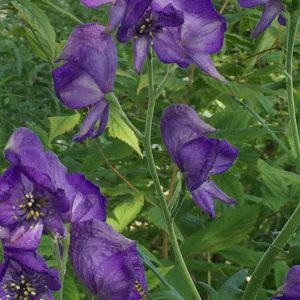Deer Resistant Plants
Showing 1–8 of 155 results
-
Acanthus spinosus Bear’s breeches Z 5-9
two-toned spikes of purple & lavender bracts
OUT OF STOCK
A WOW plant. Bodacious two-toned spikes of purple & lavender bracts, June to August. Even its leaves are attractive, glossy, deeply incised. Both flowers and leaves have thorny tips.
LIMITED QUANTITIES AVAILABLE, LIMIT OF 1 PER CUSTOMER PLEASE.
Size: 3-4' x 2-3'
Care: Sun to part shade in moist well-drained soil.
Native: Italy & TurkeyAcanthus means “thorn” and spinosus means “spine” referring to the leaves. Grown since at least 5th century B.C. Inspiration for Corinthian column capital in architecture of ancient Greece and Rome
-
Achillea clypeolata Balkan yarrow
Erect, fern-like clumps of striking silver foliage. Mustard yellow platter flowers in summer.
OUT OF STOCK – EMAIL FOR AVAILABILITY
Erect, fern-like, thick clumps of striking silver foliage. Mustard yellow platter flowers in summer. I first saw this plant at the harbor garden in Port Washington about 6 AM one fall morning. The foliage was so arresting it stopped me in my tracks.
Size: 18" x 24"
Care: sun in well-drained to moist well-drained soil. Deer and drought tolerant
Native: BalkansCollected before 1804. The Balkan yarrow is known to attract butterflies with its Yellow Flowers.
-
Achillea filipendulina Fernleaf Yarrow Z 3-9
June-July clumps of mustardy yellow platters on erect stems
June-July clumps of mustardy yellow platters on erect stems
Size: 3’-4’ x 30”
Care: Full sun. Dry, well-drained soil. Heat and drought tolerant, stands up to wind.
Native: Caucasus, Iran, Afganistan.
Wildlife Value: Deer resistant.Achillea named for Achilles, hero of Homer’s Iliad, used Achillea millefolium to stop bleeding of his wounded soldiers at the siege of Troy. Achilles learned about the uses of Achillea from Chiron, the Centaur. A. filipendulina collected by French explorer and botanist Joseph Tournefort (1656-1708) in the Levant c. 1700.
-
Achillea ptarmica ‘The Pearl’ Sneezewort, Shirtbuttons Z 3-9
Spring - summer frilly, white “shirtbuttons”
Spring – summer frilly, white “shirtbuttons”
LIMITED QUANTITES AVAILABLE, LIMIT OF 1 PER CUSTOMER PLEASE.
Size: 12-36”x 24”
Care: Full sun, well-drained to moist well-drained soil.
Native: North temperate regionsPtarmica is Greek for sneeze because this plant used for snuff. English brides carried this at their weddings and called the plant “Seven years’ love.” Cultivated in Europe since the Middle Ages and in the U.S. since the 1700’s. The double form grown in English gardens by 1597. Philip Miller (1768) referred to this as “double Maudlin.” “The Pearl” described in the May 1905 edition of The Garden as “probably giving more satisfaction than any other white-flowered hardy perennial. The Pearl is a pearl indeed.”
-
Achillea tomentosa Woolly yarrow Z 4-8
Lemony colored platter-like flower heads from June to July atop a spray of wooly foliage.
OUT OF STOCK
Lemony colored platter-like flower heads from June to July atop a spray of wooly foliage.
Size: 8” x 12”
Care: Full sun in moist to dry soil
Native: Southern to Eastern Europe
Awards: Royal Horticultural Society Award of Garden Merit.Grown in garden of Tradescant the Elder’s (1570-1638) in 1630. ”A splendid plant with fern like foliage and rich golden-yellow flower heads.” H.H. Thomas, 1915. Philip Miller’s The Gardener’s Dictionary, describes this as having “finely cut” leaves with flowers “of a bright yellow colour, and continue long in beauty.” (1768)
Achillea named for Achilles, hero of Homer’s Iliad, who used a different Achillea to stop his soldiers’ bleeding at the siege of Troy. Tomentosa means “furry” or “covered in hairs”, referring to the leaves of this plant.**LISTED AS OUT OF STOCK BECAUSE WE DO NOT SHIP THIS ITEM. IT IS AVAILABLE FOR PURCHASE AT OUR RETAIL LOCATION.
-
Aconitum napellus Monkshood Wolfsbane Z 5-8 POISON
Striking, late summer to fall tall stalks, top third covered with flowers, blue washed purple each topped with a hood, in ancient times like a monks’ hood, today like a sweatshirt’s hoody.
OUT OF STOCK
Striking, late summer to fall on the top third of tall stalks, covered with flowers, blue washed purple each topped with a hood, in ancient times like a monks’ hood, today like a sweatshirt’s hoody.
Size: 2-3’x 12”
Care: part shade, cool, moist soil
Native: Europe
Wildlife Value: Aconitums are unusual. They change sex, which, in turn increases procreation! When first blooming they have a “male phase” of about 5-6 days when pollen is available, and the plant produces more nectar and stronger scent. Then the male parts wither making the pollen available to the female parts. The pollen is toxic to bees so most avoid it leaving more for the female parts, therefore increasing fertilization. However, bees are able to collect nectar without harm. https://botany.one/2019/11/aconitum-offers-bees-more-nectar-to-carry-its-toxic-pollen/ Also deer resistant.
Awards: Elisabeth Carey Miller Botanical Garden Great Plant PicksThe name Aconitum is from the mythical hill Aconitus in Pontica where Hercules fought with Cerberus. The Monkshood reputedly sprang from the jaws of Cerberus, the guard dog of the underworld. Believed to make a potion that helped witches fly. Identified by Dioscorides in De Materica Medica for medicinal use c. 70 A.D. Philip Miller in The Gardener’s Dictionary (1768) wrote that the name Aconitum comes from Greek word for dart “because the Barbarians used to daub their darts therewith.” Used by physicians in 1200’s and to poison wolves: “This Wolf’s bayne of all poisons is the most hastie poison.” Wm. Turner, 1560’s. Called Monkshood due to the shape of each flower like a monk’s hood. Introduced to the new world by John Winthrop in 1631.
-
Actaea pachypoda syn. Actaea alba White baneberry Z 3-8
Short white spike flowers in June, conspicuous white berries in fall with a black dot on showy crimson stems.
OUT OF STOCK
Short white spike flowers in June, conspicuous white berries in fall with a black dot on showy crimson stems.
Size: 36”x 18-24”
Care: part to full shade in moist well-drained soil
Native: native to eastern and central No. America; Wisconsin native.
Wildlife Value: deer resistant
Awards: England’s Royal Horticultural Society Award of Merit and Great Plant Pick Award from Elizabeth Carey Miller Botanical Garden.Actaea is Latin meaning “elder,” the leaves resembling the elder tree. Pachypoda means thick foot referring to the stalk. The common name “baneberry” chosen because the berries are poisonous. The Blackfoot boiled the roots to cure coughs and colds. In the 1800’s, used to cure “reflex uterine headache, rheumatism, congestion in the female especially, debility and gastralgia.” Sent to England before 1768, Philip Miller.
-
Aethionema grandiflorum Persian stonecress Z 5-8
Bushy, low growing perennial with blue-green leaves and spikes of fragrant pink to lavender flowers, June-July
OUT OF STOCK
Bushy, low growing perennial with blue-green leaves and spikes of fragrant pink to lavender flowers, June-July
Size: 6-12” x 12-18”
Care: full sun in well-drained soil. Drought tolerant.
Native: Iran, Iraq, Caucasus, Turkey
Wildlife Value: attracts honeybees & other pollinators, Deer & Rabbit resistant.
Awards: Award of Garden Merit from the Royal Horticultural SocietyShort-lived perennial, but self-seeds where happy. Described in 1849 by Pierre Edmond Boissier and Rudolph Friedrich Hohenacker.








